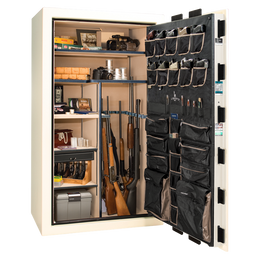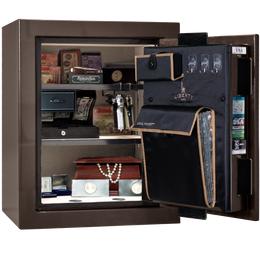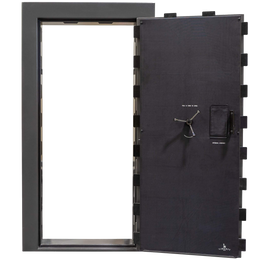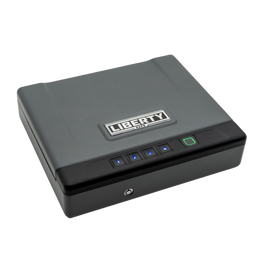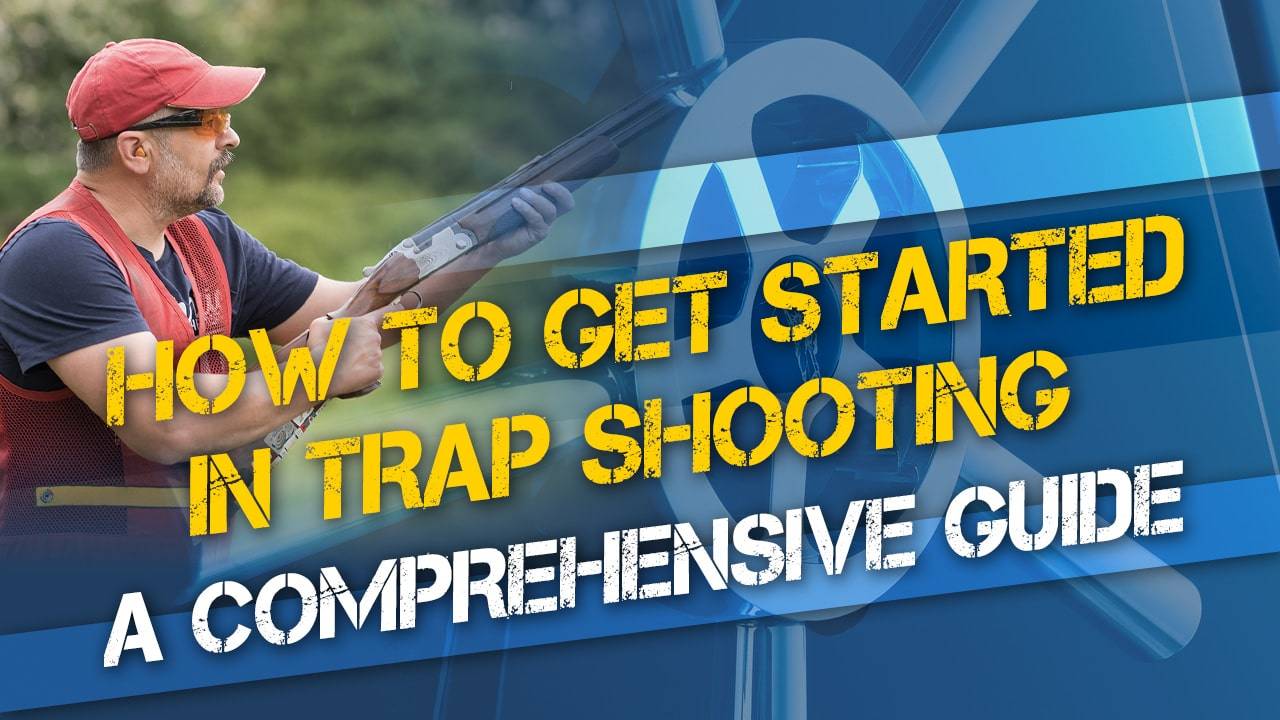Trap shooting (often called shooting trap or simply trap) is an exciting, challenging shotgun sport that appeals to beginners and long-time competitors alike. On a trap field, a 10-year-old might be shooting next to an 80-year-old, and both may be equally successful. Like golf, trap shooting is deceptively simple. You can shoot trap your whole life and still not understand all the nuances but still love the game. Trap shooting is growing in popularity and is even spreading among high-school sports leagues as a fun alternative to traditional team sports. If you’re thinking of trying it out, we have some tips and advice for you to consider. Let’s get started. Pull!
What is trap shooting? A brief overview
Trap shooting is so named due to the trap house, which is situated low to the ground, in front of the firing line. In 18th-century England where this sport originated, live pigeons were used as targets, and were released from traps (hence the name, which has perpetuated). This sporting activity was intended to sharpen shotgunners’ skills for hunting. Today, rather than live birds, special 4 ¼”-diameter clay targets resembling small Frisbees are launched at 42 miles per hour from automated clay target throwers, which oscillate back and forth within a specified range of motion. Clay targets used in the trap sports are generally bright orange in color to improve visibility.
Trap shooting is similar to skeet shooting in that shooters fire from different positions along a firing line, and clay targets are launched for participants to shoot. However, in skeet shooting, the targets are moving left-to-right or right-to-left across the field of view of the shooter (generally), whereas in trap shooting, the targets are primarily moving away and upward relative to the shooter. There is often some left or right angle as well, depending on where you are standing relative to the trap house and the random nature of how targets are launched from the left-right oscillating trap.
Trap shooting procedures
In the most common US trap sport, Amateur Trap Association (ATA) trap shooting, you (and up to 4 other shooters) stand at one of five designated stations called posts, which are located in a shallow U-shape behind the trap house. The closest position is 16 yards behind the trap house.
Starting with the shooter standing at post one on the far left, each shooter takes turns calling pull and shooting the clay target that is thrown from the trap house, until everyone has fired five rounds from their position. At that point, all shooters move to the next position to the right. (The shooter at post five turns to his/her right with the shotgun safely pointed upward and away from the other shooters, and walks behind the other shooters back to post 1.) This is repeated until each squad member has shot five rounds at all five posts, for a total of 25 shots.
If you call for a target, you are required to shoot at it (you don’t get any free chances or do-overs, in other words.) As for scoring, commonly there’s a scorer sitting and watching for broken targets and writing down your score. Whether you completely dust a target or just break a small chip off of it, it scores the same. It is your responsibility to check your own score.
Registered Trapshooting is an internationally recognized competitive sport and is more regimented as to how the targets are thrown. You also need to be a member of the organization to participate. In registered trapshooting, the rules specify that targets must be thrown no less than 48 yards, no more than 52 yards, and should be flying between 8 and 12 feet high at a 10-yard distance from the trap. Shooters stand a minimum of 16 yards from the trap houses.
By the way, after you are done with your round of trap shooting, it is customary to tip the trappers (the kids pulling/running the trap and possibly scoring for your squad) a few dollars (assuming the traps aren’t fully automated and/or your squad isn’t self-scoring).
Are there different types of trap shooting?
Yes. There are 3 common variations of trap shooting in the USA, and most follow the ATA rules. These variations are Singles, Doubles, or Handicap. Singles trap means you shoot at one clay target at a time from the posts at the 16 yard line. Doubles trap is similar, but rather than just one clay thrown per pull, two clay targets will be thrown simultaneously, one to the left and one to the right in a V pattern. Handicap trap is similar to Singles, except you shoot from posts that are further back from the trap house, based on your handicap. The better your average score, the further back you will shoot from. Trap field posts range from 16 to 27 yards behind the trap house.
Essential equipment for trap shooting success
One of the best things about trap shooting is it’s not an equipment-heavy sport. Anyone with pretty much any sort of shotgun, ear/eye protection, and a basic shell pouch can learn how to succeed in trap shooting, up to a point. Of course, as with any hobby or sporting activity, there is specialized equipment that can help you eke out that last 10 percent of performance once you’re experienced in the game.
Shotgun selection
Traditional trap shooting shotguns, if there is such a thing, are usually single-barrel, break-open (or break-action) shotguns, commonly in 12 or 20 gauge. There have been many competitive trap shooters who use semi-automatic or pump-action shotguns, but today most of the top competitors use dedicated, break-action trap shotguns. Unless you’re shooting Doubles trap, you only need one round in the gun at any time, and you only load right before you shoot. Break-action shotguns are generally preferred by ranges and clubs, since it’s easier to see that the gun is broken open and unloaded.
Trap shotguns generally have a high rib over the barrel/s. The rib is a long, flat piece of metal, polymer, or carbon-fiber running the length of the barrel, often with slots cut into it for ventilation/cooling or to reduce weight. The rib helps direct your eye to the target. On sporting, hunting, and skeet shotguns, this rib is generally not higher than about ¼” to ½” above the top surface of the barrel itself. However, on trap shotguns, this rib can be up to several inches in height.
High-rib guns were developed for trap shooting because on a trap field, all targets are thrown from under the sight plane of the shotgun, and rise in flight. A higher rib helps the shooter see fast-rising targets as well as quartering-away targets earlier in the target’s flight path, when compared to shooting a plain-barrel or flat-rib shotgun. Additionally, shotguns with high ribs can be more comfortable for older shooters with more upright head positions, as well as shooters with longer necks. The higher rib allows the shotgun’s buttpad to sit a little lower on the shoulder.
Whether you need a trap-specific shotgun is entirely up to you. However, we recommend trying out a few rounds of trap with whatever shotgun you have available, assuming it’s in good working order and you can operate it safely. The other shooters at the trap field can often provide recommendations for basic trap guns in your price range, if you decide to upgrade.
Ammunition
Most amateur trap shooters use basic target or game loads when shooting trap, and you can do very well using this type of shotgun shell. Usually these loads use smaller #7, 7.5, or 8 shot to maximize the pattern density and increase your chances of hitting the small clay targets.
There is specially loaded ammunition intended for competitive trap shooting, and many experienced trap shooters load their own cartridges. Particularly for handicap trap shooting, where you have proven to be so good that you need to start farther back from the trap house, a stouter charge of powder and/or a heavier load of shot is often used. Recoil and noise are greater with these heavier-hitting loads. So unless you have become a very experienced trap shooter and are moving back to the handicap positions, you likely will do just fine with common clay-target shotgun loads.
Shell pouch
Technically you can pull your cartridges out of a coat pocket, but most trap ranges will require or encourage the use of a belt-mounted shell pouch. This holds a box of 25 shells, and the good ones will have enough room for you to drop your empty hulls into the pouch as well for easy disposal or recycling after your round of trap is over.
You don’t want to put your box of ammunition on the ground, as it can be a safety issue with you constantly bending over to grab a shell with a shotgun in your hands. Some ranges prohibit placing your ammunition on the ground, and it’s not a good idea. Get a basic shoulder-strap pouch or belt-mounted shell pouch.
Safety gear for trap shooting
Whenever you are shooting any firearm, you should be using proper eye and hearing protection. Basic foam earplugs (used properly) are often the most effective at reducing noise decibel levels, and are perfectly adequate when shooting trap. Electronic shooting muffs are some of our favorite types of hearing protection, because they allow you to still hear normal conversation, range commands, etc., but automatically block any noise above around 89 decibels. The slimmer types of shooting earmuffs are preferred for trap shooting, since you’re shouldering a shotgun with a cheek comb pressing against your cheekbone and it can interfere with the larger earmuffs.
Our favorite type of ear protection for trap shooting lately is the new electronic earbud-type. These offer the same sound-amplification and noise-blocking benefits as the electronic muffs, but in a much more streamlined, in-ear package that doesn’t interfere with a proper cheek weld on rifles and shotguns. You can even use them to listen to audiobooks or music on bluetooth-enabled devices.
As far as eye protection, any good shooting glasses will be acceptable. Depending on the light conditions and weather at the trap field, you may prefer darker shades, different color filters, or basic clear lenses. Trial and error will help you find what your eyes prefer, or ask around your local trap range and see what most people recommend.
The art of trap shooting: techniques for success
There are multiple ways to approach the sport of trap shooting, and what works for one person may not work for another. However, we like Gil Ash’s approach, from the OSP shooting school.
Video: How to Shoot Trap | Shotgun Tips with Gil Ash
Aiming versus target focus
Gil teaches (in broad terms) that people can achieve great success on the trap field when they work on separating the hands and the eyes, focusing very hard on the bird, and moving your hands to follow where your eyes are looking. You shouldn’t be looking at the gun, and you shouldn’t even be really focusing on seeing the gun. You should never be aiming a shotgun, either, unless you’re shooting at a stationary deer or turkey. This is why high-visibility fiber-optic beads on shotguns intended for use on flying targets are not always a good idea. You don’t want your eyes to be distracted from focusing on the target.
Gil uses the concept of not just focusing on the clay target, but focusing hard enough that you can count the ridges or rings on the target. This helps keep your eyes where they should be and not becoming distracted by trying to judge distances or seeing the bead of the gun.
It’s important to understand that your starting points for HOLD, or where you are pointing the shotgun after mounting it to your shoulder before you call for the bird, and FOCUS, or where your eyes are looking/focusing before you call for the bird, are different points. Generally:
- If you’re at post 1, on the far left, your hold point will be 1-2 feet above the left top corner of the trap house.
- For post 2, hold 1-2 feet above a point halfway between the left corner and the center of the far edge of the trap house.
- For post 3, right in the middle, your hold will be 1-2 feet above the center of the trap house exit.
- For post 4, hold 1-2 feet above a point halfway between the center and the far right edge of the trap house;
- For post 5, you guessed it, hold 1-2 feet above the far top/right corner of the trap house.
Your FOCUS points should be beyond the trap house, at something you can specifically focus on. This could be a piece of trash, a specific broken target, a stick, or something similar. Where exactly you should focus from each position is a little complicated, so it’s best to watch Gil Ash’s video for a better explanation. However, in general, you want your eyes to be looking around 10-15 feet in front of the trap house so you are ready to acquire and focus on the clay bird the same distance away from the trap no matter what angle it comes out at.
When you call pull and a clay target is launched, your eyes focus hard on the target, your hands start to move the gun to where you are looking, and when your hands move the shotgun to the point where it touches the bird, you pull the trigger. Since the gun is moving, there’s a natural delay as your brain tells you when the gun is pointed correctly, and the shot will break a little above or ahead of the target, which helps account for the speed it’s moving and the time it takes for the shot column to catch up to the bird. After you break the shot, your hands and shotgun continue swinging through the motion a little bit. This is known as follow-through.
Different instructors teach different methods, but this should be enough to get you started breaking some clays.
Stance and posture
On a non-competition trap field, there will likely not be anyone watching exactly where you put your feet, but ATA rules require that you have at least one foot on the front/back center line of the station (the concrete pad just behind the post). It’s technically against the rules to stand with both feet on one half or the other of the concrete pad.
So, you usually want your non-dominant-side foot (your left foot if you shoot right-handed) to be in the center-forward position of the concrete pad, and your other foot comfortably positioned next to it in a stable, athletic position that allows you to comfortably swing your gun across the entire potential area where the clay target may be presented.
There is a great deal of personal preference involved here, but choose a foot placement and stance that allows you to quickly and comfortably move the gun where it needs to go without binding up the muscles and bones of your hips and legs. If you’re a right-handed shooter and you’re at post one on the far left, you may be opening up your stance a little and putting your torso facing more straight ahead because the majority of the targets will be moving left relative to your position.
Naturally, for position 5, you will potentially want to be more bladed-off to the trap house, with your feet and torso biased a little more to the right since from your perspective, the majority of target presentations will be moving to your right, and you’ll need to swing that way more.
However, it’s important to remember that the clay bird can exit the trap house anywhere within its legal arc swing, and there will usually be white flags or markers downrange to indicate the edges of the allowed target area. Make sure whatever stance you choose allows you to comfortably swing your shotgun anywhere within that range of left and right.
Finding your range: locating trap shooting facilities
One of the best ways to find a trap field near you is by checking the ATA website map for a club/trap shoot near you. You can also check the National Shooting Sports Foundation’s where to shoot map for ranges in your area. You can also ask at local gun shops, or check local shooting forums online.
Local shooting ranges
When looking into local trap ranges near you, be sure to call and ask about any particular rules or procedures they may have, as well as cost. You might also ask whether they adhere to amateur/ATA trap and/or Registered Trap regulations, as they can differ somewhat.
Some ranges require that you enter the facility with an un-cased shotgun, with the action open (so everyone can see it’s unloaded). That’s a good question to ask when you call them up before you go.
Some ranges may discourage or prohibit toe pads or toe rests, that allow shooters of break-action shotguns to rest the muzzle of their empty, broken-open shotguns on the toe of their shoe while waiting for their turn to load and shoot. These are very common in Europe, but in the US, where most shooters are taught the four rules of firearm safety, people can be a little weirded out by this practice. The ATA doesn’t specifically prohibit it, but does discourage it. Regardless of whether your range permits it or not, you should never rest the muzzle of a pump-action or semi-auto shotgun on a toe rest, nor any shotgun with a cartridge in the chamber. People have lost toes and feet by being stupid.
Community engagement
As noted earlier, high-school trap shooting teams are making somewhat of a comeback and trap shooting with friends can be a fun, fulfilling way to build camaraderie and spend time with people you enjoy being around. Even if you don’t have any friends who shoot trap, consider going out to the trap field and shooting with whoever is there. You might make some lifelong friends!
Store your trap gun in a US-made safe from Liberty
Whatever firearms you have, and whether you have a dedicated trap shotgun or not, remember to keep all your guns secure from theft, fire, and unauthorized access in a quality gun safe. Check out our interactive online catalog, or click our dealer locator to find a Liberty showroom near you!


